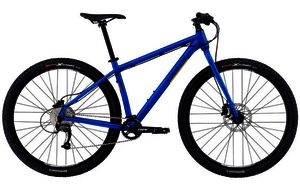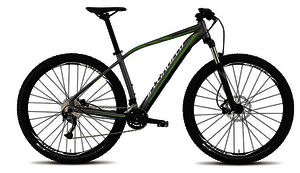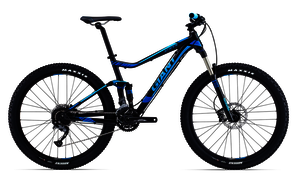Mountain bikes are all-terrain bikes: they'll go anywhere. That includes urban journeys. It's harder to equip them with commuting essentials like mudguards, and those knobbly tyres are slow on tarmac. But they have advantages too, especially for heavyweight riders.
Mountain bikes are all-terrain bikes: they'll go anywhere. That includes urban journeys. It's harder to equip them with commuting essentials like mudguards, and those knobbly tyres are slow on tarmac. But they have advantages too, especially for heavyweight riders. They're built for abuse so they're strong. Wide tyres (and suspension) make badly surfaced roads a breeze. Gears go lower than other bikes'. Brakes are better. And if you also plan to ride at forestry trail centres or on bumpy bridleways, then it's a no-brainer: you need a mountain bike.
Mountain bikes come in three configurations: rigid (no suspension); hardtail (front suspension only), and full-suspension (both ends). Suspension improves comfort and control on rough surfaces, absorbing the bumps before they come through to you. Sounds great? If you pay enough, it is. Effective suspension is expensive. Expect to pay £1,000-plus for a decent full suspension bike and £600-plus for a good quality hardtail. For that, you can get air-sprung forks and shocks that are lightweight and highly adjustable. Conversely, bad suspension – an undamped coil spring like a pogo stick - is worse than no suspension. It makes the bike heavier and absorbs pedalling energy without improving handling.
Consider how you'll use the bike too. Full suspension is fantastic for riding fast on rocky singletrack. Around town, it's overkill because mountain bikes already have big wheels and fat, shock-absorbing tyres. For urban use, a rigid mountain bike is actually better: it's lighter, more efficient, and there's less to go wrong. A rigid bike will still go off-road well enough – as long as you ride more slowly. A hardtail falls between these extremes, so is arguably the best all-rounder.
Almost all quality mountain bikes under £1000 are aluminium. Hardtail and rigid bikes may have threaded eyelets for a rear pannier rack and a rear mudguard. On a full-suspension bike, you'll need to use a backpack – or possibly a quick-release saddlebag or beam rack. Suspension forks are seldom designed for full mudguards. You can fit them using P-clips. But full mudguards are an impediment off-road, clogging with mud or debris. If you'll regularly switch between road and off-road use, mountain bike guards that fit to the seat post, down tube and fork bridge are a better compromise.
As of this year, there are two popular wheel sizes for mountain bikes: 27.5 inches (also known as 650B) and 29 inches. The smaller 26-inch wheel is disappearing except on entry-level bikes and downhill bikes. Broadly speaking, bigger wheels offer the best rolling performance – an important consideration for a bike that's also a commuter – while smaller ones are lighter and more manoeuvrable.
A more important consideration is the tyre. Spiky tread lugs dig into dirt for traction off-road but slow you down considerably on road. That buzzing noise? It's your energy going nowhere! If you're happy switching the tyres over at the weekend, you could get a pair of slick tyres specifically for use on tarmac. If not, fit a lighter-treaded rear tyre. That will reduce rolling resistance on road but won't compromise steering much off-road. Change the tyre pressures to suit the riding surface: pump them up to their maximum pressure rating for use on tarmac, and reduce it to near the minimum for use off-road.
Mountain bike gears go super low. You can expect an 11-34 or 11-36 cassette at the back, and at the front either a really compact double chainset (such as 38-24) or a small triple (24-32-42). Either set up will enable you to ride up just about any hill sitting down. And you won't have any trouble stopping coming down the other side: even a cheap mountain bike uses V-brakes, which are powerful. More expensive bikes use hydraulic discs, which translate a little lever effort into lots of stopping power.
Here are three different mountain bikes that are all good examples of their type.

Pinnacle Ramin One 29er
Less is more with this rigid mountain bike. There's no suspension fork and there's only one chainring, derailleur and shifter. This means it's lightweight for a sub-£500 bike, tipping the scales at just 12.4kg. The 9-speed gear range is okay, however, as the chainring is just 32T, yielding smaller gears than any road bike. The lack of suspension won't be a problem on roads and easier trails, and even when it gets rough the 29x2.2in tyres will take the edge off bumps. Shimano M395 hydraulic disc brakes are a plus at this price, and the Ramin has properly off-road capable frame geometry.
£475.00
www.evanscycles.com
Specialized Rockhopper Comp 29er
The Rockhopper Comp's suspension fork is better than most at this price: it's a 100mm SR Suntour XCR-Air 29, an entry-level air fork. Because it's pneumatic, you can use a shock pump to set the spring's resistance to suit your weight and riding preferences. The wheels are good too; the Stout XC rims are stiffer and support wider tyres better than narrow rims. The 18-speed Shimano Acera/Alivio/Sram X5 drivetrain has a good range despite using a double chainset, and the brakes are Tektro Gemini hydraulic discs. Grips are saddle are from Specialized's Body Geometry range, which is good for preventing aches and pains.
£650.00
www.specialized.com
Giant Stance 27.5 2
Proof that you can have a nice full-suspension bike for a three-figure price, Giant's Stance 27.5 2 offers 120mm travel front and rear. The RockShox 30 Gold Solo Air fork and Monarch R shock are effective and adjustable. Combined with a frame geometry that suits full-bore trail riding, it will be a lot of fun on forest singletrack. As a commuter, it only makes sense if you can incorporate some proper off-road sections. There are some economies, such as the entry-level 27-speed Altus/Alivio drivetrain, but the Stance 27.5 still comes with sturdy wheels and Maxxis Ardent trail tyres – in 27.5in size, as the name says.

Comments: